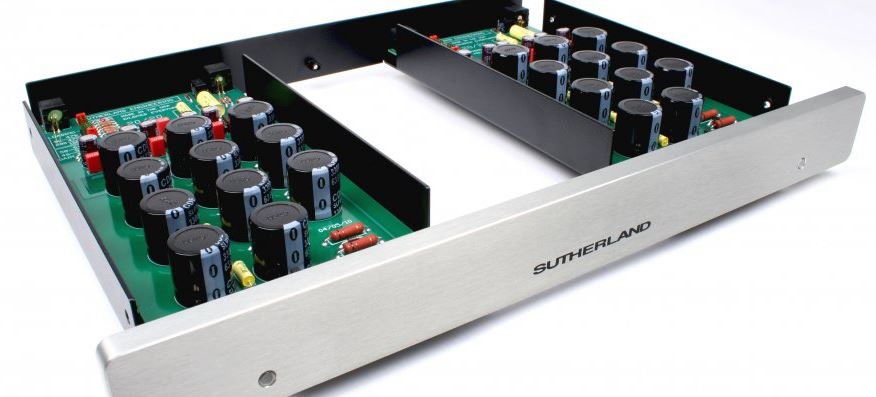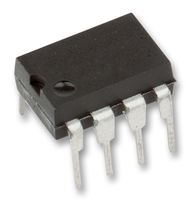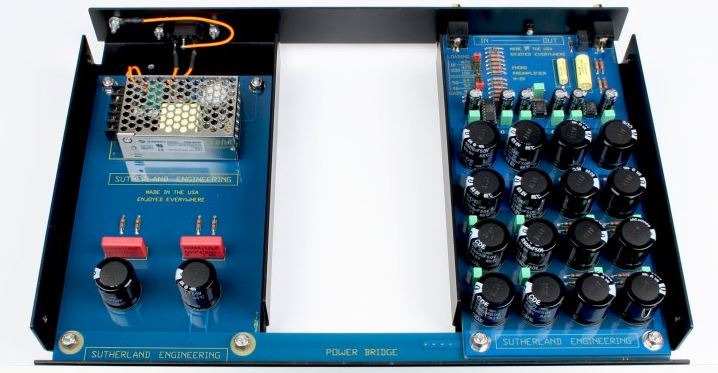The Sutherland 20/20 dual mono moving-coil/moving magnet phono cartridge preamplifier was introduced in 2010 and carries a list price of $2,199. The 20/20 differs from previous Sutherland phono preamps by being powered by the AC line, not by batteries. The design is what Ron Sutherland calls “Two Mono”. There are two entirely separate sections in the single enclosure separated by air, one section for each channel. The power comes from substantial external power supplies, which are filtered by over 35,000 microfarads of capacitance. Audio amplification is carried out by specially selected integrated circuits.

An integrated circuit contains almost all of the transistors, resistors, capacitors, and other amplifier components in a small, 8-pin DIP chip. The entire chip is about the size of your thumb nail. A discrete circuit uses separate transistors and other components, each individually mounted on a circuit board. The total size and complexity of these circuits can vary greatly. Examples of discrete circuits range from the size of a business card to the entire interior area of a full sized chassis.

The prevailing idea that an integrated circuit (IC) is sonically inferior to discrete circuits is no longer true. The sonic quality of ICs has improved by several orders of magnitude since the early “OP Amp” days in the 1980s. One benefit to integrated circuits is that since all the connections between the components are extremely short, noise can be dramatically reduced. In the case of phono preamplifiers, where we are amplifying the very tiny phono cartridge signal by 2,000 times (or more), the reduction of noise and distortion audibly increases the Signal/Noise ratio and offers a huge benefit in sonic quality.
The Sutherland DUO, $4,000, was introduced in 2013. It is also a true dual mono configuration, but with a separate component for each channel. One side of the interior holds the highly refined power supply and the other side supports the audio circuit, again separated by air. Improved over the 20/20 are a much more massive power supply with increased filtering and upgraded parts in key locations in the circuits. The circuit boards are 1/8” thick which is double the thickness of the 20/20’s boards, and the circuit boards of most other electronics, too. This added thickness significantly reduces unwanted interaction of various parts of the circuit and improves mechanical dampening of the attached parts.
Other components on hand during the almost 2 year span that these two fine phono stages were resident include a Basis 2500 Signature turntable with Vector 4 tonearm, a Miyajima Kansui and Zu Audio DL-103R phono cartridges, assorted digital gear, a Levinson 326S preamp with built in phono stage, Ayre K-5xe MP preamplifier, YG Acoustics Kipod II Signature Main Modules speakers, Magnepan 1.7 and 3.7 speakers, Dali Mentor 5 speakers (from the home theater system), and two Gallo TR-3 and TR-3D subwoofers. Power amplifiers included Spread Spectrum Technologies Ampzilla 2000 Second Edition and Acoustic Imagery Atsah monoblocks. All front end components receive their AC power from a PS Audio AV-5000 power conditioner, which is connected to the wall power with a Shunyata Anaconda CX power cord. A PS Audio Quintet, connected to the utility grid with another slithering Anaconda CX, is normally used for the power amplifiers. A variety of power cords are used elsewhere in the system, including Wyred4Sound P1 and Jerry’s DIY power cords.
The 20/20 served very well as my main phono stage for almost a year, replacing, and generally improving upon, a $6,000 (current list price; $7,200 when purchased) Whest PS.30RDT Special Edition. The 20/20 demonstrated a smoother, less “solid-state” sound with cleaner high frequencies. The bass of the 20/20 is much tighter and better defined, especially in the bottom of the bass range. The Whest has a bit more power in the lower frequencies and could fill a room more effectively. This is dependent on the speakers and room. The 20/20 presents greater leading edge POP and snap which demonstrated greater dynamics and energy. The Whest offers a more focused center image and slightly better soundstage depth with improved continuousness from the front of the stage to the rear.
The 20/20’s cleaner upper frequencies provide greater intelligibility of the words in songs, and contributes to better relief and separation of the individual performers in the mix. The Whest sounds more integrated and whole, which, perversely, can also sound relatively undifferentiated for complex or large ensembles or orchestras. Due to their different tonal balances, the Whest sounds slightly more dramatic (lower midrange) while the 20/20 sounds a bit more exciting (upper midrange).
The 20/20 is noticeably quieter which contributes to a perception of higher resolution in the upper frequencies. This outstanding resolution of the 20/20 can work against it: you can hear the different acoustic spaces that were recorded in different parts of the mix, which is distracting. The better bass of the 20/20 makes it easier to follow a bass guitar line and better understand the bassist’s style.
Regarding the different tonal signatures noted above, the Whest seems to have a very small suck out in the upper midrange and also a minor reticence in the lower treble, around 3 kHz. The 20/20 has a small perceived forwardness in a broad range of about 500 Hz-2 kHz. This is a different tonal footprint than some other phono stages but it becomes acceptable and enjoyable in short order. None of these three top drawer solid-state phono preamps have the golden glow sound of some tube preamps. They have a similar level of believability and enjoyment, two important features.

The wood sticks at the beginning of Dire Straits’ “Water of Love” sound very natural with perfect delivery of the sharp attack of the impact of the sticks hitting each other and the very densely rich decay. From this one-second sonic event, the listener can get a well-informed impression of the overall sound of the 20/20.
In contrast to the 20/20 and Whest phono preamplifiers, the Sutherland DUO presents a frequency response that sounds ruler flat. An extended break-in for a new DUO is mandatory. At 2 hours of use on a new unit, the sound is ragged and undefined. Darkness descends around the 50 hour mark, suggesting that an extended break-in period might be necessary. Passing through 150 hours, the sound is clearly opening up and becoming more enjoyable. At around 200 hours, the top end becomes clear and inviting. Around 220-250 hours break-in, the DUO’s sound seems to blossom like a flower. A tuner and reverse-RIAA box is very useful for this purpose and shortens the break-in process by weeks.
The DUO has even less background noise than the 20/20. This is easy to observe by placing the tonearm in its rest and turning the volume up. The level of background hiss is less than the already very quiet 20/20 and seems to set a new standard of quietness.
Large scale dynamics drew no special notice since the big power capabilities of the DUO always seems sufficient to deliver whatever speed and ultimate power was required by the music. Big power riffs sufficiently compressed the air in the listening room to be beyond reproach.

At the other end of the power or dB SPL range, small scale micro dynamics are very finely differentiated. This allows the listener to gain an excellent level of understanding of the subtlety and emotion of the performance. The listener is treated to rare insight into the musician’s technique and occasionally even his mood. Helped again by the exceptionally low background noise levels, very small gradations in sound pressure make the players all the more real and believable. This is often revelatory, even for well-known music. Music that I thought I knew very well consistently had new surprises for me.
Both the 20/20 and DUO have internal adjustments for gain of 40, 46, 52, 58, or 64 dB of gain. They have loading options of 100, 200, 475, 1 k, or 47.5 k Ohms.
The Sutherland 20/20 and DUO are very good phono stages. Either could – and did – provide enjoyable listening for a long time. The DUO offers improvements in linearity and naturalness and is worth the upcharge. There are two important goals for phono stage performance: resolution and low distortion. The Sutherland DUO excels at both.
Overall Ratings
Sutherland 20/20: 9 LPs
Sutherland DUO: 9.5 LPs
Link to manufacturer: Sutherland Engineering
My thanks to Mehran Farahmand at Sorasound. This review would not have been possible without Mehran’s kind assistance.
Manufacturer’s Response:
I am glad Jerry enjoyed his time with the 20/20 and DUO so much. Even if you are not shopping for a phono preamp, some of his observations can be put to good use in a general sense.
First. He showed an open mind and willingness to form his own opinion about the appropriateness of op amps in high-end audio design. We fortunately have serious and talented designers that focus their efforts on many different approaches, i.e. you will see the choice between tubes, bipolar transistors, fets, hybrids and opamps. A focus on the simplicity of single-end signal path or the symmetry of a balanced signal path. The minimalist execution of gain/loading options or the convenience of remote control. Each designer will have a favorite path and the consumer is fortunate to have those choices. So enjoy your choices.
Second. As Jerry experienced, a considerable amount of break-in time may be required to realize a product’s full potential. So the tuner with reverse RIAA is a good suggestion. Some of my designs include a built in white noise generator.
Last. Although photos show the DUO with a black face plate, that option is no longer available.
Ron Sutherland
